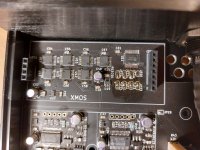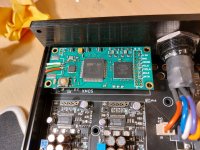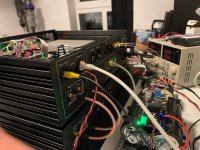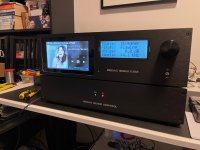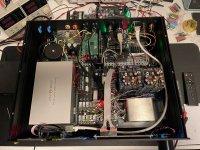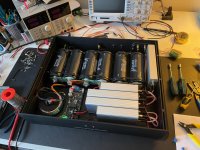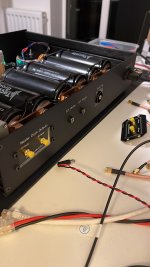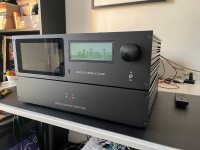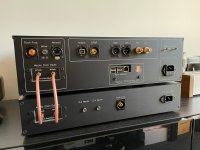Hi Doede. I wonder if you tried Ivan Bisesik output transformers. I saw a post where he offered to send you a pair. If you tried them, how do they compare to others?
Correct, I am in exchange with Ivan on results and impressions. Will report back laterHi Doede. I wonder if you tried Ivan Bisesik output transformers. I saw a post where he offered to send you a pair. If you tried them, how do they compare to others?
Hi Doede/Others - Hope all are safe and healthy.
I have some observations to share and a few questions that I want to pose to all of you learned men. Any help will be greatly appreciated.
In my DDDAC build, I retain the WaveIO board for the USB which is followed by the FifoPi (accusilicon clocks) and the latest edition is the ReclockPi. The waveio, The J3, J5 side of the Fifopi all have their discrete LPSUs. I noticed improvements over just the Waveio playing alone.
Now, from my streaming server I also have spied output available. The server is not ideal and there is scope of improvement on all levels. However, still the USB out and SPIDF out are both taken from the same system and supplied to DDDAC.
What is interesting is that despite so much work done on the USB side of things, I sense the SPIDF at times to be playing better than the USB and I am perplexed. A lot of money has gone on to the USB side and overall I believe from whatever I have read on this thread, you all mostly prefer the USB miles ahead of the SPIDF on the DDDAC.
Question 1 - What could be the cause here or what could I be doing wrong?
Question 2 - Is there anyone who has completely tried to eliminate the USB input from the DDDAC?
Question 3 - Has someone tried using the Pi2AES to supply i2s signal directly to the DDDAC motherboard? I tried it once but could not get any signal to reach the DDDAC. May be it was a connection error at my end or maybe the motherboard doesn’t acknowledge this direct i2s signal as from the back side selection switch, it can either detect usb or spidf input coming in. As per my judgment, USB selection should have been made and that is what I had done but still there was no sound. Has anyone else been able to use Pi2AES with the DDDAC?
Question 4 - Has anyone used the currently popular DDCs such as Denafrips GAIA, IRIS, etc. with the DDDAC? Has anyone tried the USB in - USB out signal method from the DDC to the DDDAC?
Question 5 - Is it possible to use these DDCs to utilise their I2S capabilities with the DDDAC? Is there a way to prepare an HDMI based I2S cable that can take the output from these DDCs and supply it straight to the motherboard of the DDDAC.
I know too many queries but these have been simmering in my mind for a long time. Need answers to get sane!! Thanks a ton in advance. Stay safe all.
I have some observations to share and a few questions that I want to pose to all of you learned men. Any help will be greatly appreciated.
In my DDDAC build, I retain the WaveIO board for the USB which is followed by the FifoPi (accusilicon clocks) and the latest edition is the ReclockPi. The waveio, The J3, J5 side of the Fifopi all have their discrete LPSUs. I noticed improvements over just the Waveio playing alone.
Now, from my streaming server I also have spied output available. The server is not ideal and there is scope of improvement on all levels. However, still the USB out and SPIDF out are both taken from the same system and supplied to DDDAC.
What is interesting is that despite so much work done on the USB side of things, I sense the SPIDF at times to be playing better than the USB and I am perplexed. A lot of money has gone on to the USB side and overall I believe from whatever I have read on this thread, you all mostly prefer the USB miles ahead of the SPIDF on the DDDAC.
Question 1 - What could be the cause here or what could I be doing wrong?
Question 2 - Is there anyone who has completely tried to eliminate the USB input from the DDDAC?
Question 3 - Has someone tried using the Pi2AES to supply i2s signal directly to the DDDAC motherboard? I tried it once but could not get any signal to reach the DDDAC. May be it was a connection error at my end or maybe the motherboard doesn’t acknowledge this direct i2s signal as from the back side selection switch, it can either detect usb or spidf input coming in. As per my judgment, USB selection should have been made and that is what I had done but still there was no sound. Has anyone else been able to use Pi2AES with the DDDAC?
Question 4 - Has anyone used the currently popular DDCs such as Denafrips GAIA, IRIS, etc. with the DDDAC? Has anyone tried the USB in - USB out signal method from the DDC to the DDDAC?
Question 5 - Is it possible to use these DDCs to utilise their I2S capabilities with the DDDAC? Is there a way to prepare an HDMI based I2S cable that can take the output from these DDCs and supply it straight to the motherboard of the DDDAC.
I know too many queries but these have been simmering in my mind for a long time. Need answers to get sane!! Thanks a ton in advance. Stay safe all.
Anyone interested in a set (45 and 49 MHz) Accusilicon clocks? I have two sets, the 318 and 338. no need to keep them in the drawer so to speak. Will offer at 75% of new price. Just PM me, first come first serve ….
@ Kartick, the spdif is pretty good at the DDDAC, but I can switch back and forth easily between them with the same track and I definitely like the fifopi reclocking over spdif only. Not miles, whatever that means, but audible for sure. Specially micro details and spatial sound reproduction.
on the other questions, I have no practical experience, so cannot offer any help….
on the other questions, I have no practical experience, so cannot offer any help….
Hey DD. Thanks for a quick reply. In fact I can also switch back and forth between spdif and fifo/usb with the same song played at the same resolution, but the impact is opposite. I suppose even with the 318 series clocks, they should not be that bad that the overall fifopi solution fall short of spidf!@ Kartick, the spdif is pretty good at the DDDAC, but I can switch back and forth easily between them with the same track and I definitely like the fifopi reclocking over spdif only. Not miles, whatever that means, but audible for sure. Specially micro details and spatial sound reproduction.
on the other questions, I have no practical experience, so cannot offer any help….
I have been using Ivan's transformers for the past 5-6 months easily! I swapped out the CMLI 15/15B trafos to place Ivan's trafos in.
Hi Doede. I wonder if you tried Ivan Bisesik output transformers. I saw a post where he offered to send you a pair. If you tried them, how do they compare to others?
DD, I wonder has no user ever tried to contact you to understand how an hdmi i2s interface can be connected to the dddac?@ Kartick, the spdif is pretty good at the DDDAC, but I can switch back and forth easily between them with the same track and I definitely like the fifopi reclocking over spdif only. Not miles, whatever that means, but audible for sure. Specially micro details and spatial sound reproduction.
on the other questions, I have no practical experience, so cannot offer any help….
You cannot connect a HDMI interface straight to the DDDAC. The signal compliancy is not compatible.
if you mean I2S over HDMI, that is different and no problem, as the HDMI receiver outputs standard I2S logic signals , which the DDDAC understands
if you mean I2S over HDMI, that is different and no problem, as the HDMI receiver outputs standard I2S logic signals , which the DDDAC understands
Speaking of I2S and clocks I would recommend this USB I2S board with AS318 clocks. It has USB3300 interface with cpld reclocking and signal buffer. It has native ASIO compatibility. Really transparent sound compared to few other I2S solutions i tried.
On my custom DDDAC i put few jumpers to omit I2S buffer (74VHCT244). Other ICs are supplied with 5V. Without buffer connected it sounds more right and fluid. I don't know how to explain but with buffer something is missing. Difference is small. Has anyone had similar experience? I have one deck only.
Ps: I will clean the board with alcohol soon 😀
On my custom DDDAC i put few jumpers to omit I2S buffer (74VHCT244). Other ICs are supplied with 5V. Without buffer connected it sounds more right and fluid. I don't know how to explain but with buffer something is missing. Difference is small. Has anyone had similar experience? I have one deck only.
Ps: I will clean the board with alcohol soon 😀
Attachments
Yes I meant using i2s over hdmi. If i want to connect the dddac to i2s (hdmi) output of a digital to digital converter (ddc), then can you please help me as to how can i make an hdmi wire with the correct pin connections so that the pins on the ddc’s i2s side match the pin connections on the i2s of the dddac? I have never done this and any help you provide could be really helpful.You cannot connect a HDMI interface straight to the DDDAC. The signal compliancy is not compatible.
if you mean I2S over HDMI, that is different and no problem, as the HDMI receiver outputs standard I2S logic signals , which the DDDAC understands
well I have not this as well. For me the I2s -> HDMI transmitter- HDMI-cable-HDMI receiver -> I2s should be considered as a black box and you should only conect the I2S output (according to documentation of the Vendor) to the DDDAC mainboard. The pins have the description at the PCB, so not sure what help you need?
Yes, I did. I use Allo Kali re-clocker on top of Sparky sbc with dietPi. I tap i2s from Kali and feed directly to DDDAC motherboard with short good quality cable. Compared to USB waveio route I got very similar (but slightly better) result so decided to eliminate waveio completely.Question 2 - Is there anyone who has completely tried to eliminate the USB input from the DDDAC?
Hi JulioSpeaking of I2S and clocks I would recommend this USB I2S board with AS318 clocks. It has USB3300 interface with cpld reclocking and signal buffer. It has native ASIO compatibility. Really transparent sound compared to few other I2S solutions i tried.
On my custom DDDAC i put few jumpers to omit I2S buffer (74VHCT244). Other ICs are supplied with 5V. Without buffer connected it sounds more right and fluid. I don't know how to explain but with buffer something is missing. Difference is small. Has anyone had similar experience? I have one deck only.
Ps: I will clean the board with alcohol soon 😀
I dont see AS318 clocks on your USB board.
Edit: Sorry you have SMD version AS318 clocks.
Last edited:
Yes those are smd version. Is there a big differece between smd and bigger tht version?Hi Julio
I dont see AS318 clocks on your USB board.
Edit: Sorry you have SMD version AS318 clocks.
Is there a way to stream the higher quality audio from a blueray disk through the dddac 1794. I ripped a Bluray disk using DVDFAB and only got 48kh wav file. I have read that somehow off of the Blueray HDMI connection on the player, higher resolution is available, but I think it would have to be played through the TV which wouldn't be so good.
Thanks
Thanks
After a huge amount of research and work I have finally completed my 5th DDDAC build, this is the best one for sure! 😀 I have called this my DDDAC Signature build as it have everything.
1. 4 DAC TENT stack with updates on the blue motherboard
2. Transformer volume control coupled output
3. I am using Roon with a Pi3 RoPieee endpoint, with Ian Canada StationPi, FiFoPi Q3, ReclockPi & SinePi 👍
4. Audio Creative Magic PSU which is CLC PSU design for the 12v and Ian's UcPure 3.3v for the ReclockPi & SinePi and a 5v SMPS to power the Pi3s
5. Andrea WTMC clocks - these are in the lower case always on and powered by Ian's UcPure
6. Custom PCB hosting an Arduino Mega board to allow full remote control for selecting inputs, volume, turning off the displays, altering brightness and contrast and more 😉
7. Custom case panels
8. Touch sensitive display to show the music that's playing ad allow another way to control the music, next track, stop etc
I would like to thank my dear friend Doede for all his dedication to this project enabling us all to build dacs like this. I would also like to thank Doede for all the extra support he has given me over the years and particularly this build, I could not have done it without him!

I would also like to thanks Ian and Andrea for there super products that really have enable this build to be something very special, IT SOUNDS AMAZING! 👍
👍
Pictures attached. 😊
1. 4 DAC TENT stack with updates on the blue motherboard
2. Transformer volume control coupled output
3. I am using Roon with a Pi3 RoPieee endpoint, with Ian Canada StationPi, FiFoPi Q3, ReclockPi & SinePi 👍
4. Audio Creative Magic PSU which is CLC PSU design for the 12v and Ian's UcPure 3.3v for the ReclockPi & SinePi and a 5v SMPS to power the Pi3s
5. Andrea WTMC clocks - these are in the lower case always on and powered by Ian's UcPure
6. Custom PCB hosting an Arduino Mega board to allow full remote control for selecting inputs, volume, turning off the displays, altering brightness and contrast and more 😉
7. Custom case panels
8. Touch sensitive display to show the music that's playing ad allow another way to control the music, next track, stop etc
I would like to thank my dear friend Doede for all his dedication to this project enabling us all to build dacs like this. I would also like to thank Doede for all the extra support he has given me over the years and particularly this build, I could not have done it without him!


I would also like to thanks Ian and Andrea for there super products that really have enable this build to be something very special, IT SOUNDS AMAZING!
 👍
👍Pictures attached. 😊
Attachments
Great project. Congratulation SimonJ.After a huge amount of research and work I have finally completed my 5th DDDAC build, this is the best one for sure! 😀 I have called this my DDDAC Signature build as it have everything.
1. 4 DAC TENT stack with updates on the blue motherboard
2. Transformer volume control coupled output
3. I am using Roon with a Pi3 RoPieee endpoint, with Ian Canada StationPi, FiFoPi Q3, ReclockPi & SinePi 👍
4. Audio Creative Magic PSU which is CLC PSU design for the 12v and Ian's UcPure 3.3v for the ReclockPi & SinePi and a 5v SMPS to power the Pi3s
5. Andrea WTMC clocks - these are in the lower case always on and powered by Ian's UcPure
6. Custom PCB hosting an Arduino Mega board to allow full remote control for selecting inputs, volume, turning off the displays, altering brightness and contrast and more 😉
7. Custom case panels
8. Touch sensitive display to show the music that's playing ad allow another way to control the music, next track, stop etc
I would like to thank my dear friend Doede for all his dedication to this project enabling us all to build dacs like this. I would also like to thank Doede for all the extra support he has given me over the years and particularly this build, I could not have done it without him!
I would also like to thanks Ian and Andrea for there super products that really have enable this build to be something very special, IT SOUNDS AMAZING!👍
Pictures attached. 😊
Maybe 12V for power supply DAC board is low. 13V would be better because UA7810 needs min.12.5VDC + 4R7 resistor before UA7810 will reduce the voltage by about 0.5V.
- Home
- Source & Line
- Digital Line Level
- A NOS 192/24 DAC with the PCM1794 (and WaveIO USB input)
